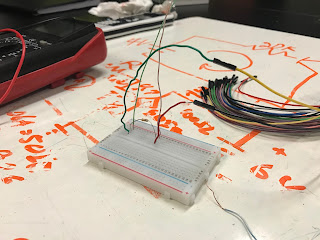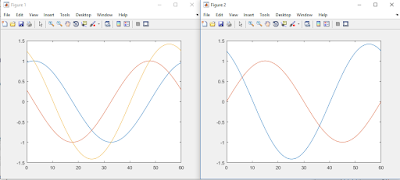Objective:
The goal of today's class meeting is to understand Thevenin's Theorem. Thevenin started working in the telegraph service and eventually became the chief inspectors of the telegraph service. When applying Thevenin's Theorem, a linear two terminal circuit can be replaced by an equivalent circuit that includes the Rth and Vth. When finding the Rth, we turn off all independent sources and find the Req. Finally we can acquire the Vth at the terminals where their is an open circuit.
Group Practice:
1. The image below shows a practice problem in which we are finding the Rth using Thevenin's Theorem. We can see that the Rth= 10 ohms. We acquire this value by replacing the voltage and current sources with a line, thus turning them off and find the Req which is the Rth.
 |
| Figure 1. In class work in which we find the Rth |
2. The second in class problem involves another circuit in which we found the Rth = 12 ohms and Vth = 40v by using Thevenin's Theorem.
 |
| Figure 2. In class work in which we find the Rth and Vth in a circuit by applying Thevenin's Theorem. |
Lab Procedures and Results:
1. The lab involves the use of Thevenin's Theorem where we compare our theoretical values of Rth and Vth with our experimental values of Rth and Vth. In order to start with our experiment, we will calculate the theoretical Values of RL and VL as seen in Figure 3. We note that the 1.5K resistor will be replaced by a 1.8K resistor since it is the only resistor available in class.
 |
| Figure 3. Schematic of circuit where the 1.5K resistor is replaced with a 1.8K resistor. |
2. The values of
Rth = 7.7K and
Vth = .4579V as seen in Figure 4.
 |
| Figure 4. The visual solution for Rth and Vth. |
3. The next step is to create the circuit from figure 3. The actual circuit can be seen below. The actual resistance measure by the digital ohmmeter are
R1K = .96K+/-.01, R4.7K = 4.6K+/-.05, R6.8K=6.66K+/-.01, R1.8K = 1.75K+/-.01, R6.8K = 6.8K+/-.01, and R2.2K=2.16K+/-.01.
 |
| Figure 5. The actual Circuit setup for experimenting on Thevenin's Theorem |
4. We measure the voltage across the terminals a-b and make sure that there is an open circuit for RL. the The voltage is
Vth = .46V+/-.01 and can bee seen in Figure 6 below. The Rth is measured to be
Rth = 7.4K+/-.01 which can be seen in Figure 7. The way we measure the Rth is by setting the voltage sources to short circuits.
 |
| Figure 6. |
 |
| Figure 7. |
5. We then pick a random resistor of
R4.7K = 4.54K+/-.01 within the range 4k<RL<10K and connected to the terminals a-b. We measure the voltage across the resistor and get a
VRL=7.4K+/-.01 which can be seen in Figure 8. below. We notice that we acquire the same thevenian voltage which is what we expect based on the theorem.
 |
Figure 8. The measure voltage of Vth using a 4.7K resistor.
|
 |
| Figure 9. Percent error between theoretical and experimental values. |
6. The last step is to connect the potentiometer between the terminal a-b. We measure and record the load function and the potentiometer resistance as seen in figure 10. We will also create a powers vs load resistance plot using only 4 measurements. We expect to reach a max power output and then drop at some point.
 |
| Figure 10. Measurements of voltage and resistance, as well as the calculations for power. |
 |
| Figure 11. Power vs load resistance plot. |
Summary of Lab and Learning Outcome:
The purpose of the lab is compare our theoretical and experimental values of Rth and Vth. Out comparison shows that Thevenin's theorem is precise based on the values that we calculated and measured which can be seen in figure 9. We see that we acquire a percent error of 3.89% for the Rth and .459% for the Vth. The low percent error satisfies our expectations of Thevenin's theorem. A potentiometer is also connected where the Rth is located which can be seen in figure 3. We then measure the voltage across the terminal a-b. The measurements are plotted in a power vs load resistance plot which can be seen in figure 11. We see that the power increases and reaches a maximum power of 6.22 micro watts, a voltage of .22V when the resistance is 8.5K.

















































